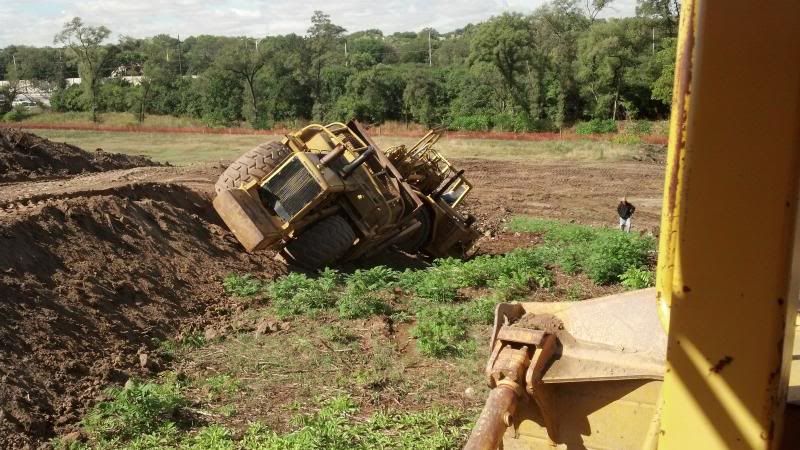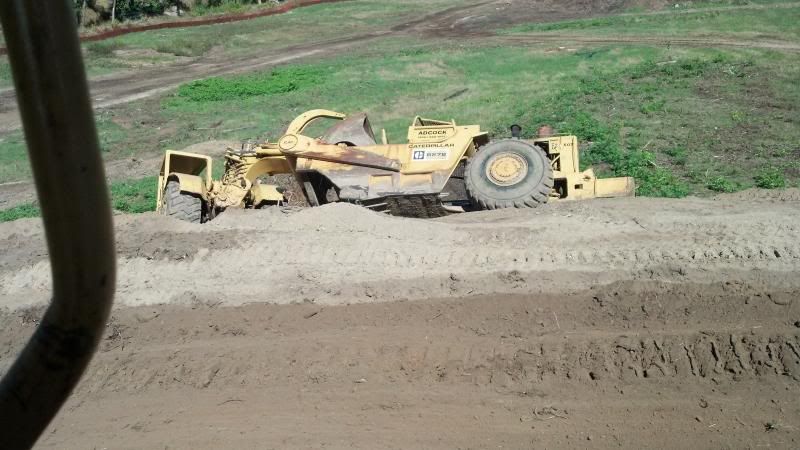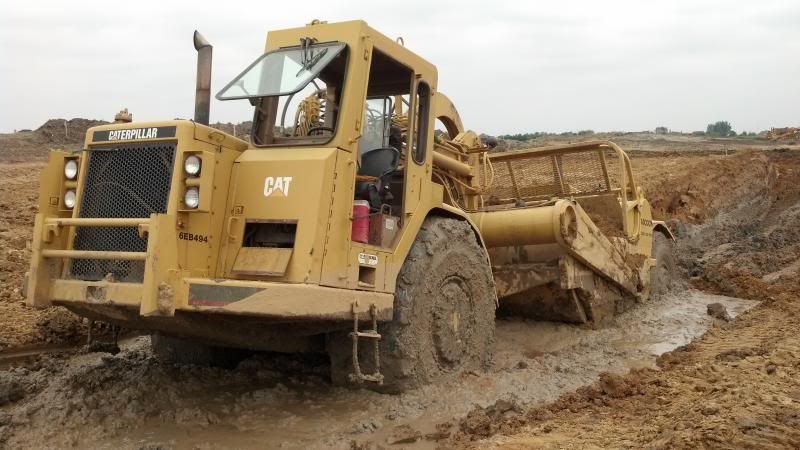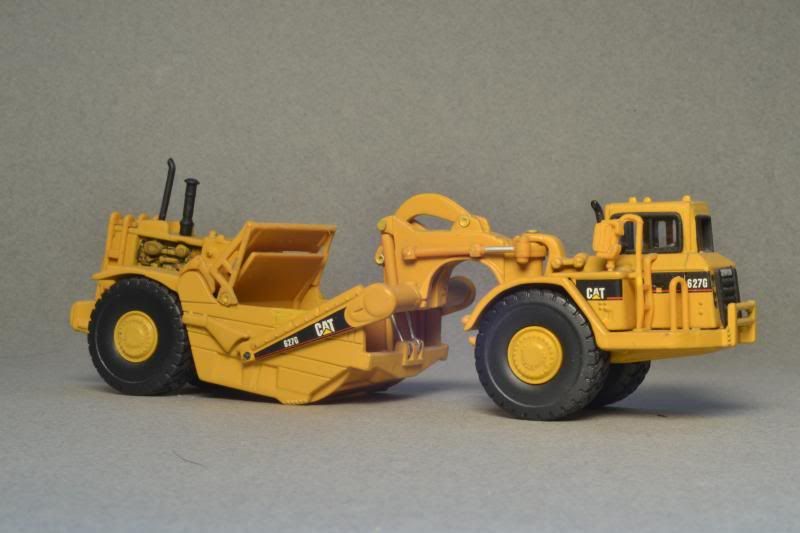Deleted
Deleted Member
Posts: 0
|
Post by Deleted on Feb 26, 2014 20:20:29 GMT -8
|
|
|
|
Post by onequiknova on Feb 26, 2014 20:33:22 GMT -8
Jim, Check out the DW scrapers at this link. The bigger the number, the bigger the scraper gets. Judging by the width, I say it's one of the larger ones. www.machinerytrader.com/drilldown/models.aspx?ETID=1&catid=1054&Manu=CATERPILLAR Also check out the 15 through 482 pull pans. They would be pulled by a D8-D10 sized dozer, usually with the blade removed. Would be a pretty easy kitbash to a much more common piece of equipment. The same basic pull pans are still used today. |
|
|
|
Post by onequiknova on Feb 26, 2014 20:46:10 GMT -8
Here's a couple pics I took at work last year. These are the more common type of scraper used since the 60's. This is a mid 70's model.    Needless to say, this guy didn't last. A mid 90's model. Very little change in design since the 60's.  |
|
Deleted
Deleted Member
Posts: 0
|
Post by Deleted on Feb 26, 2014 20:50:04 GMT -8
Thanks for the link. It appears to be a model DW20. It is a BIG machine.
Love the scraper on its side.....that was an aw s.........................! So how do you save your very expensive machine from such a predicament?
|
|
|
|
Post by onequiknova on Feb 26, 2014 21:01:03 GMT -8
I hooked the push block on the back of the scrapper with the dozer blade and shoved the back of the scrapper back on the pile, then spun it 90*. Then I pulled it off the side of the pile from the front with a cable. Luckily it was a small pile. When you do that on a 30' high stock pile, it doesn't end so pretty.
|
|
|
|
Post by mlehman on Feb 26, 2014 23:32:02 GMT -8
Jim, Think you've got it sorted out, but a few more thoughts. It strikes me as 50s, early 60s in general. Don't know if that matches what you found, but this type of prime mover was at least as common if not more common back then. The newer two-wheel prime mover style scraper came about as hydraulics got up to snuff to handle these sorts of loads. The older style 4-wheel prime mover operated the system primarily via cables and pulleys, although I think some hydraulics were involved as these were improved. I'd say yours is one of the intermediate versions with some hydraulics on the scraper, but not running the articulation yet. The scraper itself often sported a pair or more of front wheels to take most of the load off the prime mover, but yours doesn't so another sign its toward the more modern versions of these. I'd say yours is to scale, on the large side as has been noted. But they weren't too much smaller than that or too much bigger, either. I saw a lot of these traveling as they built the interstates in the 60s, since dad was in the Air Force and I spent a lot of time listening to my younger siblings ask if we were there yet. I always looked forward to construction zones, even though they slowed things down. I managed to pick up a Norscot Cat scraper in the scratch and dent part of the LHS last week for $5 or about a 1/10th of MSRP, just needed a little TLC, rear power unit glued back on, and massaging. It's actually a bit too modern for my tastes, but too good a deal to pass up.   |
|
|
|
Post by Judge Doom on Feb 27, 2014 2:08:20 GMT -8
Yeah, I'd say it looks like a DW20 of the 50's, like this one: A smaller ancestor of the giant-ass heavy-duty earthmover Cat 660 (and dual engined 666) scrapers of the 60's and 70's. Cat stopped making 3-axle "tractor" scrapers with the demise of the 666B in 1979: www.contrafedpublishing.co.nz/Historical/Classic+Motorscrapers/The+Caterpillar+666.htmlStill a few DW20's around, most seem to be privately owned. The 660/666's are quite rare, but some are still in operation in Southern California, re-engined with Detroit Diesel Series 60 engines to meet emissions requirements. Look at 'em move: |
|
|
|
Post by peoriaman on Feb 27, 2014 6:41:27 GMT -8
"This is ADCOCK country". Hope he's not trying to fill that wet hole with good dirt! Jim, if you're trying to make a flatcar load out of it, I'd suggest just detaching the scraper and use it as a load without the tractor. That way it would be harder to tell if the scale is wrong (and it would probably be shipped separate anyway). |
|
|
|
Post by onequiknova on Feb 27, 2014 8:22:48 GMT -8
"This is ADCOCK country". Hope he's not trying to fill that wet hole with good dirt! You from around here? |
|
|
|
Post by onequiknova on Feb 27, 2014 11:07:01 GMT -8
Jim, Think you've got it sorted out, but a few more thoughts. It strikes me as 50s, early 60s in general. Don't know if that matches what you found, but this type of prime mover was at least as common if not more common back then. The newer two-wheel prime mover style scraper came about as hydraulics got up to snuff to handle these sorts of loads. The older style 4-wheel prime mover operated the system primarily via cables and pulleys, although I think some hydraulics were involved as these were improved. I'd say yours is one of the intermediate versions with some hydraulics on the scraper, but not running the articulation yet. The scraper itself often sported a pair or more of front wheels to take most of the load off the prime mover, but yours doesn't so another sign its toward the more modern versions of these. I'd say yours is to scale, on the large side as has been noted. But they weren't too much smaller than that or too much bigger, either. I saw a lot of these traveling as they built the interstates in the 60s, since dad was in the Air Force and I spent a lot of time listening to my younger siblings ask if we were there yet. I always looked forward to construction zones, even though they slowed things down. I managed to pick up a Norscot Cat scraper in the scratch and dent part of the LHS last week for $5 or about a 1/10th of MSRP, just needed a little TLC, rear power unit glued back on, and massaging. It's actually a bit too modern for my tastes, but too good a deal to pass up.   The Norscot model benefits greatly by removing the lugs cast into the side of the bowl which keeps the bowl from being lowered to the ground. The only time the bowl should be off the ground is when the machine is in motion. For a flat car load, or displayed as parked, the bowl should be in the down position.  The drooping front needs to be addressed as well. |
|
|
|
Post by mlehman on Feb 27, 2014 11:26:36 GMT -8
John, Thanks for the tip on the lugs. Very useful. As for the sagging front, I've done some work on that since the pic was taken. The swiveling joints seemed really sloppy on this unit. It may have been stepped on or crushed a bit in the box, which showed some damage. I managed to work some shims into one of the joints, which helped a little, but still didn't make me happy. Finally, I took a plastic LED headlight holder salvaged from a Bachmann 70 tonner, which fit in between the hydraulic unit at the bottom rear of the prime mover and the curved hitch of the scarper above. Any other ideas on taking the sag out -- beyond some judiciously applied CA, which means it also won't swivel so well afterwards.  |
|
|
|
Post by onequiknova on Feb 27, 2014 11:35:31 GMT -8
Mine were destined to be flat car loads, so I glue mine. I've got one mounted on an Intermountain 60' flat packed away somewhere.
|
|
|
|
Post by thb401 on Feb 27, 2014 11:44:53 GMT -8
|
|
|
|
Post by Spikre on Feb 27, 2014 18:04:10 GMT -8
 Jim, according to the "Mini Movers" section of the 1968 AHM Catalog Your machine should have the 1 axle tractor pulling it. U-308,,,,,.69cents. Caterpillar Tractor Scraper U-301 ,,,,,29cents,is the Caterpiller 4 wheel Tractor. OOPPS---5373---$2.49,,,Steel Fishbelly Flat Car with 1 Motor Scaper. this one does come with the 4 wheel Tractor. U.S.Army 54' Flat car with 6 wheel Buckeye Trucks,was sold by Walthers in the 80s as a plain Flat with out a load there may have also been some EKO items earlier,but by 1968 they were gone. the Prices in the 1968 Catalog were generally low,too bad they didn't stay that way. AHM sold EKO cars and trucks in the early 60s.Walthers now and then has some in stock.they are sort of crude,but they do look like the models they are supposed to be. at $.39 they were worth it,but at $2.98+ are sort of way over priced. Spikre 
|
|
|
|
Post by mlehman on Feb 27, 2014 21:38:09 GMT -8
I trimmed the tabs on the side of the scraper pan, but just enough so it would go all the way down.  Then I looked at the swivel joint again and decided if CA was one answer, maybe I could CA some pillow blocks in. The worst that could happen is it would get glued right.   She sits up perky now. The pillow blocks allow things to still move, but take most of the slop out of the mechanism. Also got the rear air cleaner looking right.  Now it's engaged in grading the new spur up to Camp 13.  |
|
|
|
Post by runs2waynoka on Feb 28, 2014 0:04:57 GMT -8
More on Umex- linkSays the scraper is a Cat 631A... I have one of the Umex/Roco graders that I plan on painting and weathering eventually. It's one of the later 1980s Roco-made models with the snowplow. Anyone know for sure what Cat model it represents? It's supposed to be a Cat 16 but I think it looks more like a Cat 12/12F from the pictures I've looked at. |
|
|
|
Post by TBird1958 on Feb 28, 2014 10:25:41 GMT -8
Here's a couple of inexpensive Norscot models that I disassembled, added some parts to and repainted riding Atlas flat. As loads they're ok I guess. I have the companion Cat scraper that'll take a pic of soon.  |
|
|
|
Post by Judge Doom on Feb 28, 2014 15:04:12 GMT -8
More on Umex- linkSays the scraper is a Cat 631A... I have one of the Umex/Roco graders that I plan on painting and weathering eventually. It's one of the later 1980s Roco-made models with the snowplow. Anyone know for sure what Cat model it represents? It's supposed to be a Cat 16 but I think it looks more like a Cat 12/12F from the pictures I've looked at. The 631A is the 2-axle version, it doesn't appear the pure 630A scraper is listed on that site. I notice there's a later Atlas/Roco release listed as "1405 - Caterpillar 630A tractor plus 482C scraper", but checking the internets it seems it's an actual 630 tractor hitched to a 482 pull-along scraper. The 630A seems to be basically an improved DW20, still using cable control (B-model got the hydraulics). Cat scraper nomenclature seems to follow that a last digit of 0 = a 3 axle version (with tractor), 1 = regular 2 axle single engine machine, 3 & 5 = elevated loading, 6 & 7 = dual engines. www.contrafedpublishing.co.nz/Historical/Classic+Motorscrapers/The+Caterillar+630A.html |
|